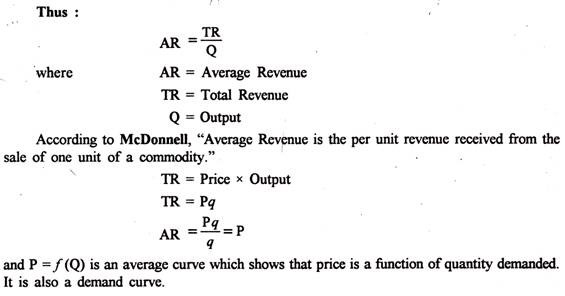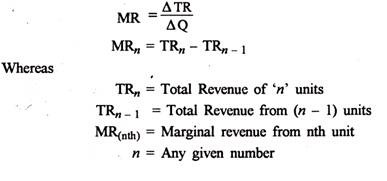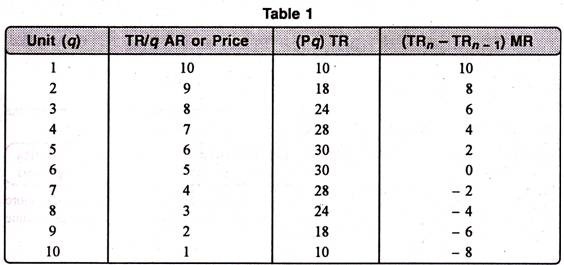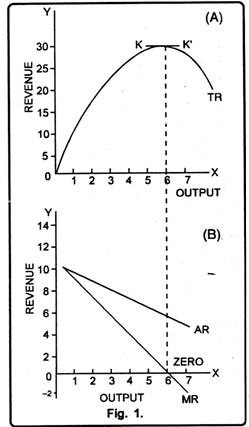Revenue Types : Total, Average and Marginal Revenue!
The term revenue refers to the income obtained by a firm through the sale of goods at different prices. In the words of Dooley, ‘the revenue of a firm is its sales, receipts or income’.
The revenue concepts are concerned with Total Revenue, Average Revenue and Marginal Revenue.
1. Total Revenue:
The income earned by a seller or producer after selling the output is called the total revenue. In fact, total revenue is the multiple of price and output. The behavior of total revenue depends on the market where the firm produces or sells.
ADVERTISEMENTS:
“Total revenue is the sum of all sales, receipts or income of a firm.” Dooley
Total revenue may be defined as the “product of planned sales (output) and expected selling price.” Clower and Due
“Total revenue at any output is equal to price per unit multiplied by quantity sold.” Stonier and Hague
2. Average Revenue:
Average revenue refers to the revenue obtained by the seller by selling the per unit commodity. It is obtained by dividing the total revenue by total output.
“The average revenue curve shows that the price of the firm’s product is the same at each level of output.” Stonier and Hague
3. Marginal Revenue:
Marginal revenue is the net revenue obtained by selling an additional unit of the commodity. “Marginal revenue is the change in total revenue which results from the sale of one more or one less unit of output.” Ferguson. Thus, marginal revenue is the addition made to the total revenue by selling one more unit of the good. In algebraic terms, marginal revenue is the net addition to the total revenue by selling n units of a commodity instead of n – 1.
ADVERTISEMENTS:
Therefore,
A. Koutsoyiannis, “The marginal revenue is the change in total revenue resulting from selling an additional unit of the commodity.”
If total revenue from (n) units is 110 and from (n – 1) units is 100.
in that case
MRnth = TRn – TRn _ 1 = 100 – 100
MRnth = 10
MR in mathematical terms is the ratio of change in total revenue to change in output
MR = ∆TR/∆q or dR/dq = MR
Total Revenue, Average Revenue and Marginal Revenue:
ADVERTISEMENTS:
The relation of total revenue, average revenue and marginal revenue can be explained with the help of table and fig.
Table Representation:
The relationship between TR, AR and MR can be expressed with the help of a table 1.
From the table 1 we can draw the idea that as the price falls from Rs. 10 to Re. 1, the output sold increases from 1 to 10. Total revenue increases from 10 to 30, at 5 units. However, at 6th unit it becomes constant and ultimately starts falling at next unit i.e. 7th. In the same way, when AR falls, MR falls more and becomes zero at 6th unit and then negative. Therefore, it is clear that when AR falls, MR also falls more than that of AR: TR increases initially at a diminishing rate, it reaches maximum and then starts falling.
ADVERTISEMENTS:
The formula to calculate TR, AR and MR is as under:
TR = P x q
Or TR = MR1 + MR2 + MR3 + MR3 +….. MR„
TR
ADVERTISEMENTS:
AR = TR/q MR = TRn – TRn _ x
In fig. 1 three concepts of revenue have been explained. The units of output have been shown on horizontal axis while revenue on vertical axis. Here TR, AR, MR are total revenue, average revenue and marginal revenue curves respectively.
In figure 1 (A), a total revenue curve is sloping upward from the origin to point K. From point K to K’ total revenue is constant. But at point K’ total revenue is maximum and begins to fall. It means even by selling more units total revenue is falling. In such a situation, marginal revenue becomes negative.
Similarly, in the figure 1 (B) average revenue curves are sloping downward. It means average revenue falls as more and more units are sold.
In fig. 1 (B) MR is the marginal revenue curve which slopes downward. It signifies the fact that MR with the sale of every additional unit tends to diminish. Moreover, it is also clear from the fig. that when both AR and MR are falling, MR is less than AR. MR can be zero, positive or negative but AR is always positive.





